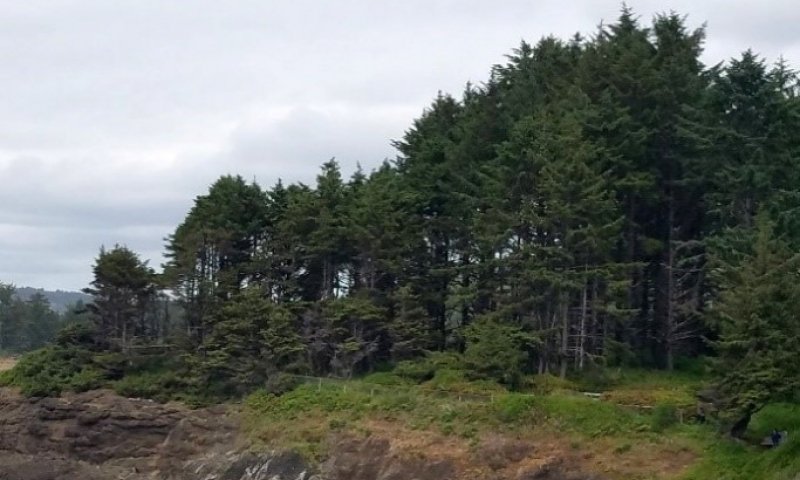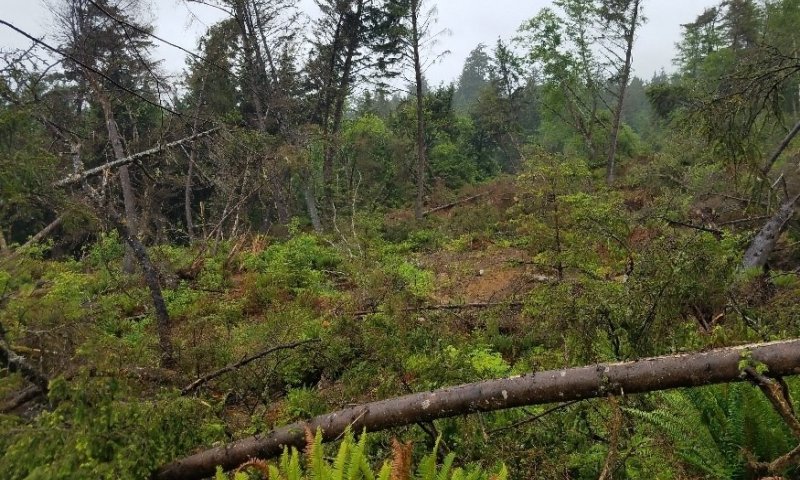

Natural Resources
Conservation Service
Ecological site F004AB405OR
Coastal Salt Spray Forest
Last updated: 1/23/2025
Accessed: 12/21/2025
General information
Provisional. A provisional ecological site description has undergone quality control and quality assurance review. It contains a working state and transition model and enough information to identify the ecological site.
MLRA notes
Major Land Resource Area (MLRA): 004A–Sitka Spruce Belt
This resource area is along the coast of the Pacific Ocean. It is characterized by a marine climate and coastal fog belt. The parent material is primarily glacial, marine, or alluvial sediment and some scattered areas of Tertiary sedimentary rock and organic deposits. Glacial deposits are dominant in the northern part of the MLRA in Washington; marine and alluvial deposits and eolian sand are dominant along the southern part of the Washington coast and extending into Oregon. The mean annual precipitation ranges from 52 to 60 inches near the beaches to more than 190 inches in the inland areas of the MLRA.
Andisols and Inceptisols are the dominant soil orders in the MLRA, but Spodosols, Entisols, and Histosols are also present. The soils are shallow to very deep and very poorly drained to somewhat excessively drained. They are on hilly marine terraces and drift plains; coastal uplands, hills, and foothills; flood plains; and coastal dunes, marshes, and estuaries.
The soil temperature regimes of MLRA 4A are moderated by the proximity to the Pacific Ocean, which eases the differences between the mean summer and winter temperatures. The seasonal differences in temperature are more pronounced in adjacent MLRAs further inland. Included in MLRA 4A are soils in cooler areas at higher elevations or on northerly aspects that have an isofrigid temperature regime.
The soil moisture regimes of MLRA 4A are typified by soils that do not have an extended dry period during normal years. Many of the soils further inland in MLRA 2 have a dry period in summer. Soils in low-lying areas and depressions of MLRA 4A are saturated in the rooting zone for extended periods due to a high water table or long or very long periods of flooding or ponding.
MLRA 4A Soil Temperature Regimes
Isomesic The mean annual soil temperature (measured at a depth of 20 inches) is 46 to 59 degrees F, and the difference between the mean winter and summer temperatures is less than 11 degrees. The seasonal soil temperatures and difference between the mean winter and summer temperatures are moderated by the proximity to the ocean and the effects of fog in summer.
Isofrigid The mean annual soil temperature (measured at a depth of 20 inches) is 32 degrees F to less than 46 degrees, and the difference between the mean winter and mean summer temperatures is less than 11 degrees. The seasonal soil temperatures and difference between the mean winter and summer temperatures are moderated by the proximity to the ocean and the effects of fog in summer. The temperatures are cooler than in surrounding lowlands because of the higher elevation and differences in slope and aspect.
MLRA 4A Soil Moisture Regimes
Udic The soil rooting zone is not dry in any part for more than 90 cumulative days in normal years. Soil moisture does not limit plant growth because of the fog in summer.
Aquic The soil is virtually free of dissolved oxygen due to saturation of the rooting zone. The soils are saturated for extended periods during the growing season and may be subject to long or very long periods of ponding and flooding.
Refer to Keys to Soil Taxonomy for complete definitions of the soil temperature and moisture regimes.
LRU notes
The Central Sitka Spruce Belt land resource unit (LRU B) of MLRA 4A is along the west coast of Washington and Oregon. The LRU extends from the Chehalis River in Washington to South Slough in Oregon, and it is bounded on the west by the Pacific Ocean. This area consists of sand dunes, flood plains, and marine terraces that extend a few miles east and are parallel to the Pacific Ocean, and it transitions to steeper and higher elevation ridges and mountainsides of the western slopes of the Coast Range in Oregon. Near the shore in coastal lowland areas, the parent material is dominantly eolian (wind-deposited) sand, alluvium, and marine sediment. Residuum, colluvium, and landslide deposits derived from sedimentary and basaltic sources are on the coastal foothills and mountains, and minor additions of recent alluvium are along the river valleys. Several major rivers carved steep, narrow valleys through the coastal mountains and foothills before entering broader coastal valleys. Subduction zones along the Pacific Coast may cause significant earthquakes and tsunamis, which would disrupt the ecological processes beyond what is described in this ecological site description.
Classification relationships
National vegetation classification: G751 North Pacific Western Hemlock-Sitka Spruce-Western Redcedar Seasonal Rainforest; A3608 Sitka Spruce-Salmonberry Mesic Forest Alliance
Ecological Systems of Washington State community type: North Pacific Seasonal Sitka Spruce Forest
Plant associations of the Oregon Dunes National Recreation Area: Sitka spruce/Salal-Salmonberry Forest (PISI/GASH-RUSP)
National Park Service association groups: Sitka spruce/False lily of the Valley Forest; Sitka spruce-(red alder)/Salmonberry/Swordfern Forest
Ecological site concept
This ecological site is on marine terraces of the western coastline of the Pacific Northwest, from southern Washington through central Oregon. The site is exposed to extremely high winds and salt spray. Elevation typically is 50 to 400 feet, and slope is 0 to 50 percent.
The maritime climate is characterized by cool, moist summers and cool, wet winters. The mean annual precipitation is 70 to 105 inches. Coastal fog provides supplemental moisture in summer. Snowfall is rare, and it is not persistent when it occurs. The mean annual air temperature is 48 to 52 degrees F.
The soils that support this ecological site are in the isomesic temperature regime and udic moisture regime. They generally formed in colluvium and residuum derived dominantly from volcanic, basaltic, or metasedimentary rock. Areas of soils that are shallow to bedrock or are skeletal and have a high content of rock fragments and areas of rock outcroppings are on the steeper slopes. These areas can be significant locally.
The soil parent material along the coast is exposed to a heightened weathering regime due to moderated temperatures and high precipitation. Enhanced weathering and organic matter from the dense vegetative cover have resulted in an accumulation of a particular suite of organic and metal oxide compounds, a process called andisolization. The level of andisolization varies within this ecological site, but Andisols and andic intergrades have been identified. A unique set of soil properties has developed as a result of andisolization, including an improved water-holding capacity, a high content of organic matter, and high phosphorous retention. This process is most typical in soils that formed in weathered volcanic ash, but a unique combination of climatic conditions and vegetation has resulted in these soil properties in coastal areas of the Pacific Northwest.
The most common overstory species is Sitka spruce (Picea sitchensis). Regeneration is limited by the canopy cover, and it commonly is in gaps where sunlight is most available. Red alder (Alnus rubra) may be dominant in the overstory in the gaps. Common understory species include salmonberry (Rubus spectabilis), salal (Gaultheria shallon), evergreen huckleberry (Vaccinium ovatum), western swordfern (Polystichum munitum), and false lily of the valley (Maianthemum dilatatum).
The most common natural disturbance on this site is windthrow following large coastal storms, which creates pockets of forest openings. Although wildfires are uncommon, the site is susceptible to catastrophic that are stand replacing (Taylor, 1990). Landslides may occur along the steep coastal hillslopes. Unnatural disturbances include grazing, urban sprawl, and establishment of non-native species.
Table 1. Dominant plant species
| Tree |
(1) Picea sitchensis |
|---|---|
| Shrub |
(1) Gaultheria shallon |
| Herbaceous |
(1) Polystichum munitum |
Click on box and path labels to scroll to the respective text.






